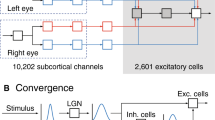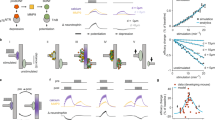Abstract
Neurons in the visual cortex respond preferentially to edge-like stimuli of a particular orientation1. It is a long-standing hypothesis that orientation selectivity arises during development through the activity-dependent refinement of cortical circuitry2,3,4. Unambiguous evidence for such a process has, however, remained elusive5,6,7. Here we argue that, if orientation preferences arise through activity-dependent refinement of initially unselective patterns of synaptic connections, this process should leave distinct signatures in the emerging spatial pattern of preferred orientations. Preferred orientations typically change smoothly and progressively across the cortex1. This smooth progression is disrupted at the centres of so-called pinwheels8,9, where neurons exhibiting the whole range of orientation preferences are located in close vicinity10. Assuming that orientation selectivity develops through a set of rules that we do not specify, we demonstrate mathematically that the spatial density of pinwheels is rigidly constrained by basic symmetry principles. In particular, the spatial density of pinwheels, which emerge when orientation selectivity is first established, is larger than a model-independent minimal value. As a consequence, lower densities, if observed in adult animals, are predicted to develop through the motion and annihilation of pinwheel pairs.
This is a preview of subscription content, access via your institution
Access options
Subscribe to this journal
Receive 51 print issues and online access
$199.00 per year
only $3.90 per issue
Buy this article
- Purchase on Springer Link
- Instant access to full article PDF
Prices may be subject to local taxes which are calculated during checkout




Similar content being viewed by others
References
Hubel, D. H. & Wiesel, T. N. Receptive fields, binocular interaction and functional architecture in cat's visual cortex. J. Physiol. 160, 215–243 (1962).
von der Malsburg, C. Self-organization of orientation sensitive cells in the striate cortex. Kybernetik 14, 85–100 (1973).
Miller, K. D. Amodel for the development of simple cell receptive fields and the ordered arrangement of orientation columns through activity-dependent competition between on- and off-center inputs. J. Neurosci. 14, 409–441 (1994).
Swindale, N. V. The development of topography in the visual cortex: a review of models. Network 7, 161–247 (1996).
Movshon, J. A. & Van Sluyters, R. C. Visual neural development. Annu. Rev. Psychol. 32, 447–522 (1981).
Gödecke, I. & Bonhoeffer, T. Development of identical orientation maps for two eyes without common visual experience. Nature 379, 251–254 (1996).
Crair, M. C., Gillespie, D. C. & Stryker, M. P. The role of visual experience in the development of columns in cat visual cortex. Science 279, 566–570 (1998).
Swindale, N. V., Matsubara, J. A. & Cynader, M. S. Surface organization of orientation and direction selectivity in cat area 18. J. Neurosci. 7, 1414–1427 (1987).
Bonhoeffer, T. & Grinvald, A. Iso-orientation domains in cat visual cortex are arranged in pinwheel-like patterns. Nature 353, 429–431 (1991).
Maldonado, P. E., Gödecke, I., Gray, C. M. & Bonhoeffer, T. Orientation selectivity in pinwheel centers in cat striate cortex. Science 276, 1551–1555 (1997).
Albus, K. & Wolf, W. Early post-natal development of neuronal function in the kitten's visual cortex: A laminar analysis. J. Physiol. 348, 153–185 (1984).
Chapman, B. & Stryker, M. P. Development of orientation selectivity in ferret visual cortex and effects of deprivation. J. Neurosci. 13, 5251–5262 (1993).
Chapman, B., Stryker, M. P. & Bonhoeffer, T. Development of orientation preference maps in ferret primary visual cortex. J. Neurosci. 16, 6443–6453 (1996).
Frisch, U. Turbulence (Cambridge University Press, Cambridge, (1995)).
Sompolinsky, H. & Shapley, R. New perspectives on the mechanisms for orientation selectivity. Curr. Opin. Neurobiol. 7, 514–522 (1997).
Bock, G. & Cardew, G. (eds) Development of the Cerebral Cortex (Wiley, Chichester, (1995)).
Miller, K. D. Synaptic economics: Competition and cooperation in synaptic plasticity. Neuron 17, 367–370 (1996).
LeVay, S. & Nelson, S. B. in Vision and Visual Dysfunction 266–315 (Macmillan, Houndsmill, (1991)).
Halperin, B. T. in Physics of Defects, Les Houches, Session XXXV, 1980 (eds Balian, R., Kléman, M. & Poirir, J.-P.) 813–857 (North-Holland, Amsterdam, (1981)).
Durbin, R. & Mitchinson, G. Adimension reduction framework for understanding cortical maps. Nature 343, 644–647 (1990).
Erwin, E., Obermayer, K. & Schulten, K. Models of orientation and ocular dominance columns in the visual cortex: A critical comparison. Neural Comp. 7, 425–468 (1995).
Obermayer, K. & Blasdel, G. G. Singularities in primate orientation maps. Neural Comp. 9, 555–575 (1997).
Rao, S. C., Toth, L. J. & Sur, M. Optically imaged maps of orientation preference in primary visual cortex of cats and ferrets. J. Comp. Neurol. 387, 358–370 (1997).
Lowel, S., Freeman, B. & Singer, W. Topographic organization of the orientation column system in large flat-mounts of the cat visual cortex: A 2-deoxyglucose study. J. Comp. Neurol. 255, 401–415 (1987).
Bonhoeffer, T., Kim, D.-S., Malonek, D., Shoham, D. & Grinvald, A. Optical imaging of the layout of functional domains in area 17 and across the area 17/18 border in cat visual cortex. Eur. J. Neurosci. 7, 1973–1988 (1995).
Bosking, W. H., Zhang, Y., Schofield, B. R. & Fitzpatrick, D. Orientation selectivity and the arrangement of horizontal connections in tree shrew striate cortex. J. Neurosci. 17, 2112–2127 (1997).
Horton, J. C. & Hocking, D. R. Anatomical demonstration of ocular dominance columns in striate cortex of the squirrel monkey. J. Neurosci. 16, 5510–5522 (1996).
Rényi, A. Probability Theory (North-Holland, Amsterdam, (1970)).
German, S. Some averaging and stability results for random differential equations. SIAM J. Appl. Math. 36, 86–105 (1997).
Niebur, E. & Wörgötter, F. Design principles of columnar organization in visual cortex. Neural Comp. 6, 602–614 (1994).
Acknowledgements
We thank S. Löwel, H.-U. Bauer, K. Pawelzik, K. Miller, A. V. M. Herz, H. Dinse, P.Heil and G. Langner for discussion, and S. Löwel, F. Hoffsümmer, J. Sandhaas and T. Dresbach for helpful comments on the manuscript. This work was supported by the Deutsche Forschungsgemeinschaft and the Max-Planck-Gesellschaft.
Author information
Authors and Affiliations
Corresponding author
Rights and permissions
About this article
Cite this article
Wolf, F., Geisel, T. Spontaneous pinwheel annihilation during visual development. Nature 395, 73–78 (1998). https://doi.org/10.1038/25736
Received:
Accepted:
Issue Date:
DOI: https://doi.org/10.1038/25736
This article is cited by
-
Active nematics
Nature Communications (2018)
-
Stochastic Network Models in Neuroscience: A Festschrift for Jack Cowan. Introduction to the Special Issue
The Journal of Mathematical Neuroscience (2016)
-
Orientation Maps in V1 and Non-Euclidean Geometry
The Journal of Mathematical Neuroscience (2015)
-
On the Effects on Cortical Spontaneous Activity of the Symmetries of the Network of Pinwheels in Visual Area V1
The Journal of Mathematical Neuroscience (2015)
-
Monochromaticity of Orientation Maps in V1 Implies Minimum Variance for Hypercolumn Size
The Journal of Mathematical Neuroscience (2015)
Comments
By submitting a comment you agree to abide by our Terms and Community Guidelines. If you find something abusive or that does not comply with our terms or guidelines please flag it as inappropriate.



